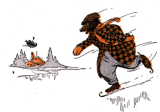|
Little Ice Age
 Tree rings and ice cores have been extensively used to reconstruct climate during the last 1,000 years. Beginning about 1450 A.D. an interval of relative cold, often called the Little Ice Age, has been identified. Occurring within the current warm interglacial period, the Little Ice Age cannot be regarded as a full glacial episode since the high latitudes of the Northern Hemisphere landmasses remained largely free of permanent ice cover. Nevertheless, the term has been used to describe an epoch of renewed glacial advance. Although many regions of the world experienced cooling during the period 1450 to 1890 A.D., with average surface temperatures in many regions at least 1C lower than those of today, its use has been criticised because it has not conclusively been considered to be an event of global significance. Tree rings and ice cores have been extensively used to reconstruct climate during the last 1,000 years. Beginning about 1450 A.D. an interval of relative cold, often called the Little Ice Age, has been identified. Occurring within the current warm interglacial period, the Little Ice Age cannot be regarded as a full glacial episode since the high latitudes of the Northern Hemisphere landmasses remained largely free of permanent ice cover. Nevertheless, the term has been used to describe an epoch of renewed glacial advance. Although many regions of the world experienced cooling during the period 1450 to 1890 A.D., with average surface temperatures in many regions at least 1C lower than those of today, its use has been criticised because it has not conclusively been considered to be an event of global significance.
There is considerable evidence that the Little Ice Age consisted of two main cold stages of about a century's length. These occurred in the seventeenth an nineteenth centuries, with relative warmth arising in the sixteenth and eighteenth centuries. Glaciers advanced in Europe, Asia and North America, whilst sea ice in the North Atlantic expanded with detrimental effects for the colonies of Greenland and Iceland.
The causes behind the Little Ice Age, whether global in extent or not, are not well understood. Three climate change mechanisms that operate on century time scales have been considered, volcanic eruptions, variations in solar energy, and changes in ocean circulation, although none of these on their own seem to reliably predict the observed climate changes throughout the Little Ice Age. More probably, a combination of these and other climate forcing processes has together influenced the climates of the last 1,000 years.
|

